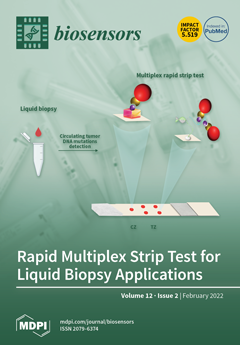Hexavalent chromium, namely, Cr(VI), is a significant threat to ecological and food safety. Current detection methods are not sensitive to Cr(VI). A photoelectrochemical (PEC) sensor based on bismuth vanadate (BiVO
4) was developed for sensitive detection of Cr(VI). First, BiVO
4-X
[...] Read more.
Hexavalent chromium, namely, Cr(VI), is a significant threat to ecological and food safety. Current detection methods are not sensitive to Cr(VI). A photoelectrochemical (PEC) sensor based on bismuth vanadate (BiVO
4) was developed for sensitive detection of Cr(VI). First, BiVO
4-X (X: the pH of the reaction precursor solution) was synthesized using a facile surfactant-free hydrothermal method. The BiVO
4-X morphology was well controlled according to pH values, showing rock-like (X = 1), wrinkled bark-like (X = 4), carnation-like (X = 7), and the collapsed sheet-like morphologies (X = 9, 12). BiVO
4-7 exhibited excellent photoelectric performance due to a proper band structure under visible light and a large specific surface area. Then, BiVO
4-7 was used to construct a PEC sensor to detect Cr(VI), which was demonstrated to have a low detection limit (10 nM) and wide detection range (2–210 μM). The BiVO
4-7 PEC sensor had a stable output signal, as well as excellent reproducibility, repeatability, and selectivity. We used the BiVO
4-7 PEC sensor to detect Cr(VI) in real environmental and food samples, resulting in a satisfactory recovery of 90.3–103.0%, as determined by comparison with results obtained using a spectrophotometric method. The BiVO
4-7 PEC sensor is promising for practical application to heavy metal detection in the food and environment.
Full article






